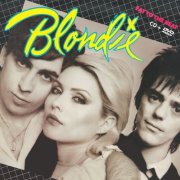 With the temperature dropping, it's time to find someone to keep you warm. Find your hookups with our online dating guide!
With the temperature dropping, it's time to find someone to keep you warm. Find your hookups with our online dating guide!
- Alternative
- 2007
- Buy the CD
Reviewed by Will Harris
()
If you’re of a mind to remedy this situation and investigate something beyond that aforementioned greatest-hits collection…well, obviously, this is supposed to be a review of Eat to the Beat, but if we’re to be completely honest, Parallel Lines really should be the first Blondie studio album you buy. (You might not be able to trust a critic’s opinion any farther than you can throw it, but you can certainly trust the quality of an album that includes “Hanging on the Telephone,” “One Way or Another,” “Sunday Girl,” and “Heart of Glass.”) But if you’re looking for a second pick, we can certainly offer you a few reasons to take Eat to the Beat under consideration.
There’s good reason to consider Eat to the Beat the “forgotten” Blondie album, even though it’s shifted enough copies since its release in 1979 to earn platinum status. As the follow-up to 1978’s Parallel Lines, which remains the most successful album of the band’s career, Eat to the Beat was a commercial disappointment; it only made it to #17 on the charts, and none of its singles cracked the top 20. Before the band could be written off as has-beens, however, their contribution to the “American Gigolo” soundtrack – “Call Me” – became a #1 smash, and they followed their success with 1980’s Autoamerican, which featured two more #1 hits, “The Tide Is High” and “Rapture.”
But what of poor Eat to the Beat?
C’mon, hasn’t anyone ever told you not to judge an album by its chart showing? Even if we weren’t writing this review, we’d probably pick Eat to the Beat as Blondie’s second-best album. First and foremost, it opens with “Dreaming,” three minutes and eight seconds of pop perfection that effortlessly earns nominations in the categories of Best Lead-Off Track Ever and Greatest Drum Intro Ever. “Atomic” is far better known in the UK, where it reached #1 on the singles charts; the guitar riff comes within spitting distance of the one that powers Neil Diamond’s “Girl, You’ll Be A Woman Soon,” but the dance beat during the verses and layered harmonies during the choruses more than succeed in making the song a classic. Similarly, “The Hardest Part” opens by sounding a whole lot like David Bowie’s “Fashion,” but it quickly evolves into more danceable territory. “Die Young, Stay Pretty” absorbs reggae influences in much the same manner as Joe Jackson’s early work, while “Slow Motion” has a bit of a Motown feel to it. The greatest thing about Eat to the Beat, though, is that it manages within the course of 12 tracks to go from punk rock (the title track) to lullaby (“Sound-A-Sleep”) and feel comfortable everywhere in-between as well.
For existing fans of the band, the DVD that’s included with this reissue is arguably the best addition to the Blondie discography since 1993’s Blonde and Beyond rarities collection, providing video companions for all 12 songs on the album. Some are live performances, some are actual videos, but given that they were all filmed when Debbie Harry was at her absolute hottest, just about any red-blooded American boy will find them worth watching. Even adjusting for the fact that you couldn’t get away with nearly as much in the ‘70s, the way Debbie looks in the video for “The Hardest Part” can only be described as a total “grrrrrrrrrrrrr, baby!” situation. Complaint-wise, though, it’s hard to believe that EMI would go out of its way to reissue this album with a bonus DVD, only to leave off the four bonus tracks that had already been tacked onto the 2001 reissue.
So there you go: now, if someone comes up to you on the street and asks you to name a Blondie album, you’ve got several to choose from, and if they ask you what their second-best album is, you can proudly declare, “By God, it’s Eat to the Beat, I tell you!”
Let it never be said that we at Bullz-Eye aren’t doing our part to educate the world.
You can follow us on Twitter and Facebook for content updates. Also, sign up for our email list for weekly updates and check us out on Google+ as well.











